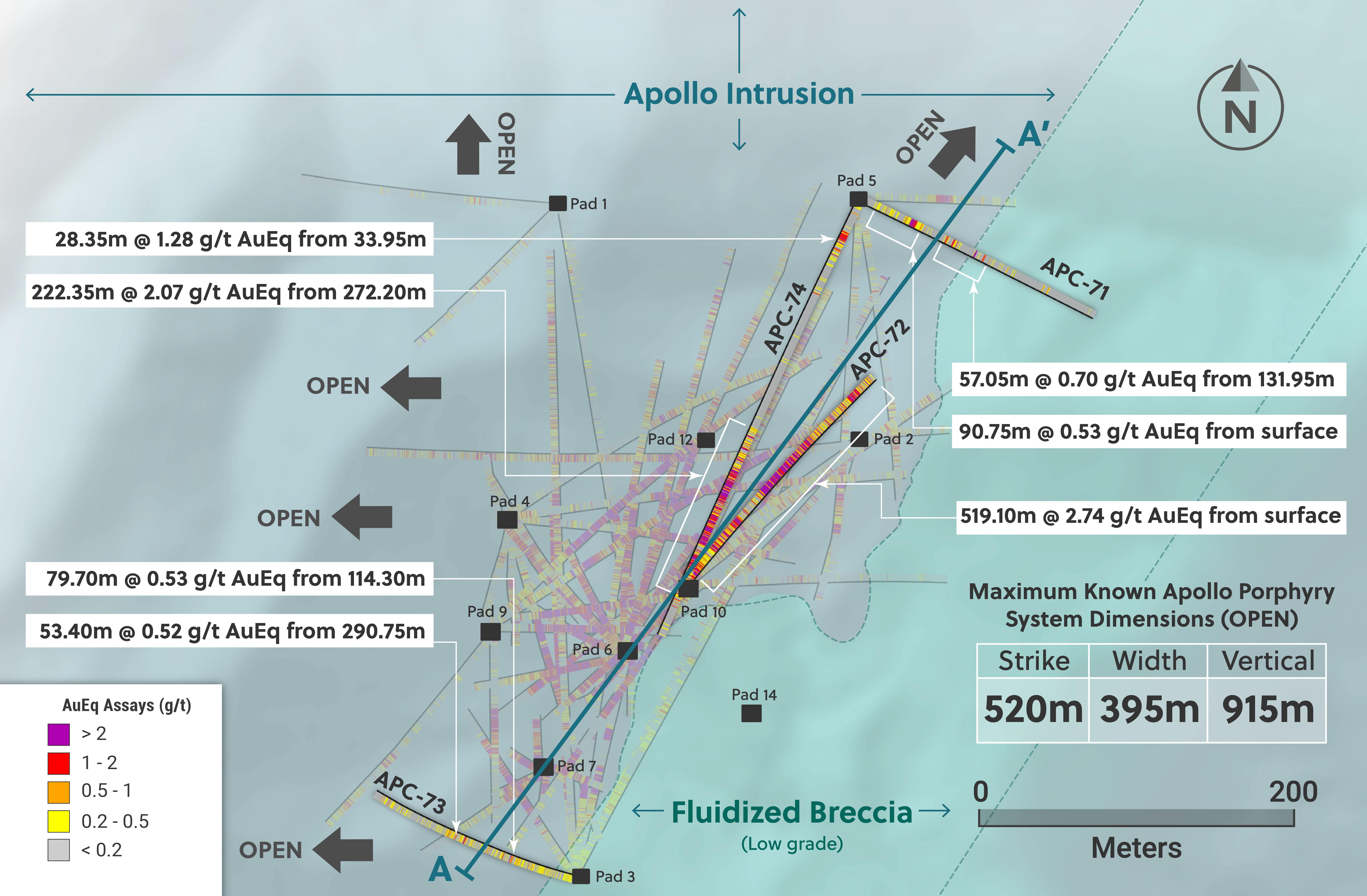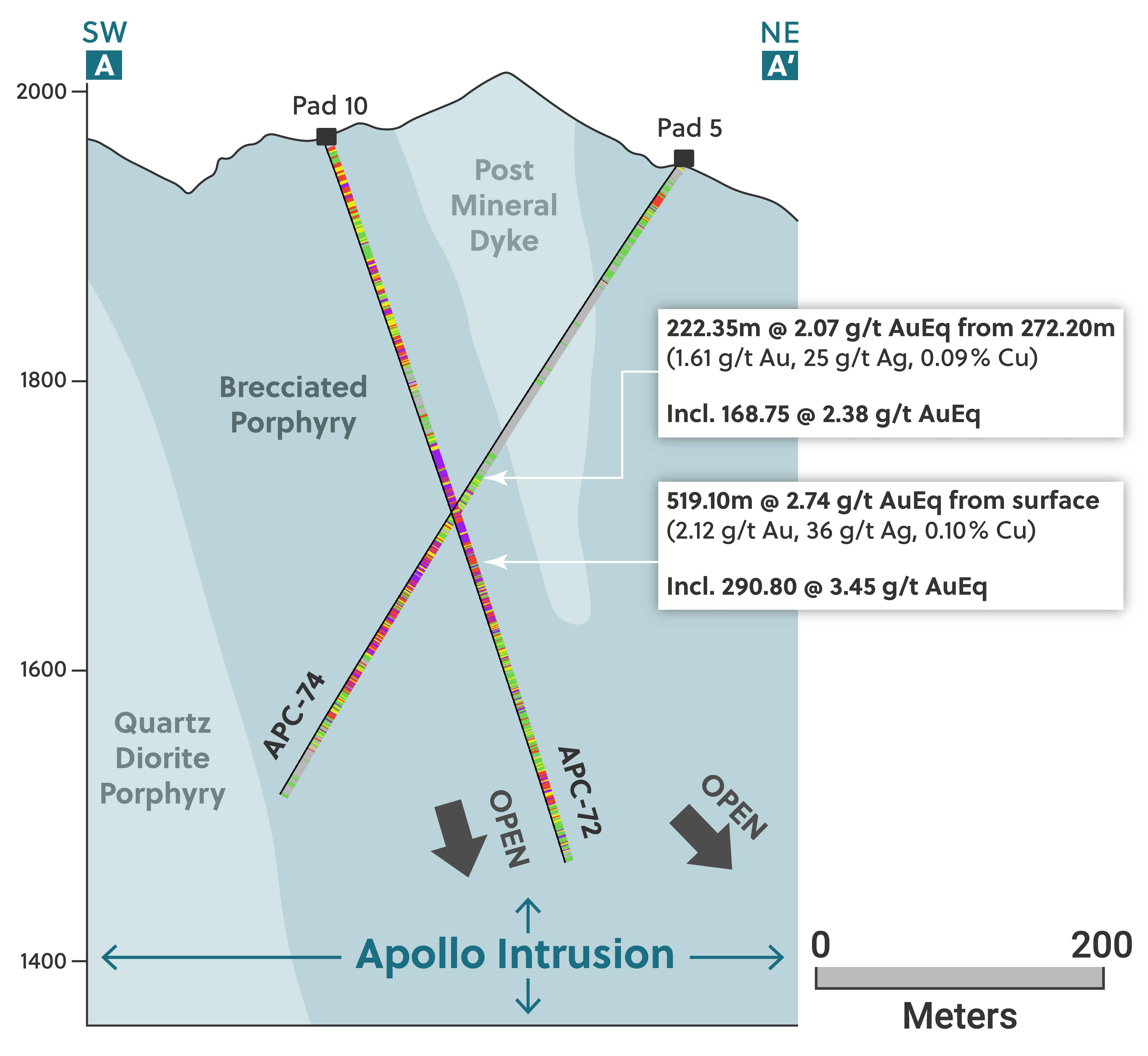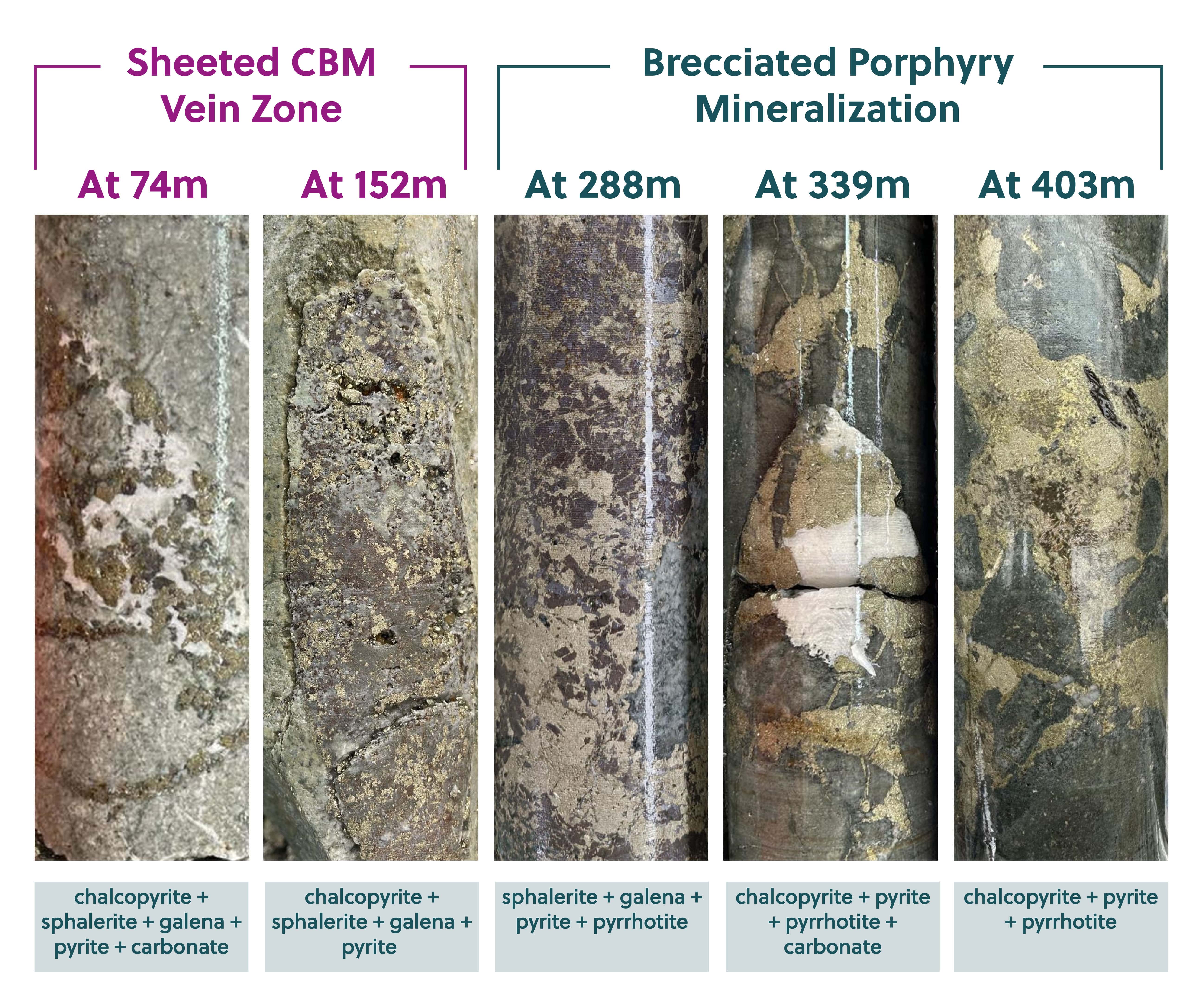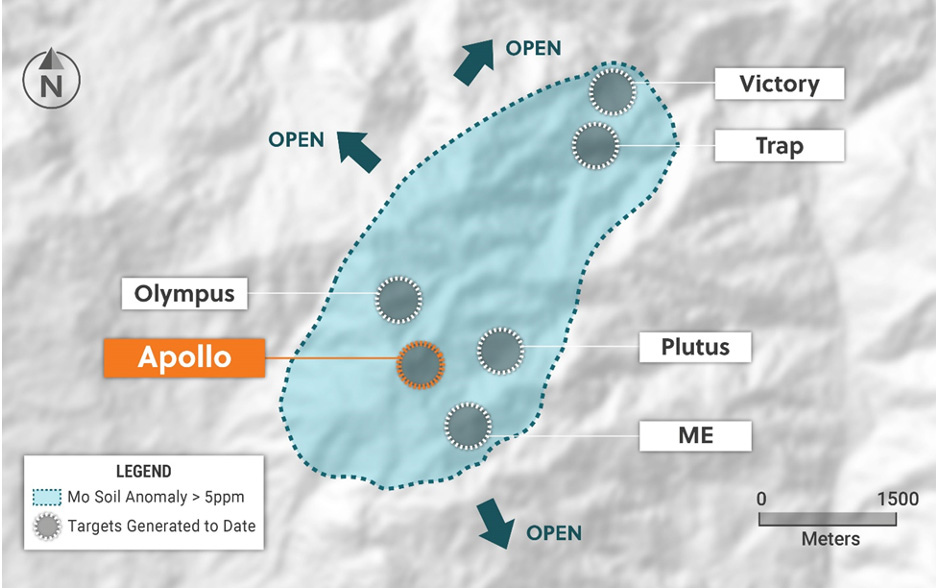- APC-72 intersected 519.10 metres grading 2.74 g/t gold equivalent from surface including 290.80 metres grading 3.45 g/t gold equivalent in a remarkably continuous and newly discovered high-grade subzone within the eastern portion of the Apollo porphyry system (“Apollo”).
- At 1,424 g/t gold equivalent on a gram x metre basis, APC-72 represents the largest grade accumulation drilled to date at Apollo.
- APC-74 was drilled perpendicular to the Apollo brecciated porphyry and returned a near to true width intercept of 222.35 metres grading 2.07 g/t gold equivalent commencing at a vertical depth of 260 metres below surface. The hole also cut a near surface extension of the system in the northeast near the drill hole collar where no prior shallow drilling has taken place.
- Exploration drilling for the remainder of 2023 has two principal objectives:
- Expansion of the Apollo porphyry system to the north, west and depth through directional drilling. Five directional holes have been completed with two additional holes underway with assays pending.
- Exploration drilling at the ME and Trap targets. Three holes have been completed at ME with assay results pending and drilling at Trap is expected to commence in November. Three widely spaced reconnaissance holes were drilled at Trap in 2022 with the discovery hole intersecting copper-silver-gold mineralization yielding 102.3 metres @ 1.53 g/t AuEq (see press release dated September 27, 2022).
Ari Sussman, Executive Chairman commented: “Our team continues to unlock value at Apollo with an intelligent approach to geological targeting resulting in the identification of a significant new subzone of cross cutting mineralization, which has now been validated by the amazing drill hole APC-72. Additionally, the directional drilling program is progressing very well with potential lateral and vertical visual extensions to the Apollo system in hand. We anticipate results from the first fan of directional holes in November.”
Toronto, Ontario, October 30, 2023 - Collective Mining Ltd. (TSX: CNL, OTCQX: CNLMF) (“Collective” or the “Company”) is pleased to announce assay results for four holes drilled in the Apollo target area, which is part of the Guayabales project located in Caldas, Colombia. The Apollo target area, which covers an area measuring 1.2 kilometres x 1 kilometres, already hosts an outcropping high-grade, bulk tonnage copper-silver-gold porphyry system (“Apollo”) and additional yet untested or lightly tested porphyry targets. The porphyry system at Apollo owes its excellent metal endowment to an older copper-silver and gold porphyry system being overprinted by younger precious metal rich, carbonate base metal veins (intermediate sulphidation porphyry veins) within a magmatic, hydrothermal inter-mineral breccia and diorite porphyry bodies currently measuring 520 metres x 395 metres x 915 metres and open for expansion.
Details (See Table 1 and Figures 1-4)
This press release outlines results from four holes drilled within and peripheral to the Apollo system. APC-72 and APC-74 were drilled in the opposite direction, northeast and southwest, respectively, to fill gaps in the current wireframe model and to test for high grade mineralization. APC-72 intersected a new high-grade subzone within the block model in an area with limited prior drilling. APC-71 and APC-73 were drilled in the northeast and southwest respectively and designed to test for lower grade mineralization peripheral to the brecciated porphyry body and forming part of the overall footprint of Apollo.
APC-72 was drilled northeastwards from Pad 10 to a final downhole depth of 528.45 metres (523 metres vertical due to topography). The hole commenced in grade from surface within oxides and transition zone and drilled continuous mineralization to the end of the hole passing through an upper zone of sheeted carbonate base metal (“CBM”) veining before continuing into brecciated porphyry over its 519.10 metres in length. The first 227.75 metres downhole from surface intersected a stockwork of CBM veining which overprints mineralized, quartz diorite porphyry with sulphide content averaging as follows: sphalerite (0.5%), galena (0.3%), pyrite (1.0%) and pyrrhotite (0.2%). The hole entered brecciated porphyry at 230.30 metres depth and remained in such for the balance of the hole with numerous quartz diorite clasts observed and a sulphide cement matrix consisting of abundant chalcopyrite (up to 4.0%), pyrite (up to 4.0%) and pyrrhotite (up to 0.8%) with some overprinting CBM veins. The complete assay results for the hole are summarized in Table 1 with highlights as follows:
- 519.10 metres @ 2.74 g/t gold equivalent from surface (consisting of 2.12 g/t gold, 36 g/t silver and 0.10% copper) including:
- 290.80 metres @ 3.45 g/t gold equivalent from 230.30 metres downhole.
APC-72 returned much higher grades than expected and has materially improved the grade block model for this portion of the deposit. The hole has yielded the largest grade accumulation intersected to date at Apollo with 1,424 g/t gold equivalent on a gram x metre basis.
APC-74 was drilled southwest from Pad 5 to a maximum downhole depth of 532.10 metres (425 metres vertical due to topography). The hole commenced in grade at 33.95 metres downhole with a 28.35 metre zone of brecciated porphyry mineralization overprinted by CBM veins. At 272.20 metres downhole, continuous mineralization was intercepted for 222.35 metres and consisted of an upper portion of sheeted CBM veins for 53.6 metres followed by 168.75 metres of high grade, brecciated porphyry. The sheeted CBM vein zone hosts sphalerite (up to 0.3%), galena (up to 0.1%) and pyrite (up to 1.0%), while the brecciated porphyry zone below this hosts a sulphide matrix fill consisting of chalcopyrite (up to 1.0%), pyrite (up to 1.5%), sphalerite (up to 0.3%), galena (up to 0.3%), pyrrhotite (up to 0.7%) and some fine, free gold in traces. The following assay results are highlighted:
- 28.35 metres @ 1.28 g/t gold equivalent from 33.95 metres downhole (consisting of 0.74 g/t gold, 31 g/t silver and 0.06% copper) including:
- 13.45 metres @ 1.90 g/t gold equivalent from 33.95 metres downhole and;
- 222.35 metres @ 2.07 g/t gold equivalent from 272.20 metres downhole (consisting of 1.61 g/t gold, 25 g/t silver and 0.09% copper) including:
- 168.75 metres @ 2.38 g/t gold equivalent from 325.80 metres downhole in brecciated porphyry mineralization.
APC-74 was drilled perpendicular to the Apollo brecciated porphyry and therefore the intercept of 222.35 metres represents a near true width of the main porphyry body in this location. The hole was drilled into an area of the deposit with very little previous drilling and will improve the current wireframe model. Furthermore, the upper 28.35 metres intercept of brecciated porphyry confirms an extension of the Apollo porphyry system to the north.
APC-71 was drilled east-southeast from Pad 5 to test the northeastern extremity of the Apollo porphyry system outside of the brecciated portion of the porphyry system. The hole was drilled to a maximum downhole depth of 353.35 metres (276 meters vertical due to topography) and encountered, from surface, 90.75 metres of porphyry mineralization with veinlets of magnetite (up to 0.5%) and pyrite (up to 0.8%). At 131.95 metres, the hole intersected a second mineralized zone for 57.05 metres in length consisting of brecciated porphyry body with a sulfide matrix consisting of chalcopyrite traces, pyrite (up to 0.4%), sphalerite (up to 0.3%), galena (up to 0.2%) and pyrrhotite traces. The following assay results as highlighted:
- 90.75 metres @ 0.53 g/t gold equivalent from surface (consisting of 0.10 g/t gold, 23 g/t silver and 0.04% copper) including:
- 26.55 metres @ 1.30 g/t gold equivalent from 70.20 metres downhole and;
- 57.05 metres @ 0.70 g/t gold equivalent from 131.95 metres downhole (consisting of 0.54 g/t gold, 10 g/t silver and 0.02% copper) including:
- 16.95 metres @ 1.58 g/t gold equivalent from 131.95 metres.
The mineralized intercepts drilled in APC-71 confirms the continuity of the recently announced northeast extension to the system in hole APC-67 which intercepted 55.55 metres @ 1.31 g/t AuEq (see press release dated September 7, 2023).
APC-73 was drilled steeply in a westerly direction from Pad 3 to test for lower grade mineralization outside to the south of the brecciated portion of the Apollo porphyry system. The hole was drilled to a maximum downhole depth of 551.75 metres (579 metres vertical due to topography). The hole intersected two zones of mineralization. The first, at 114.30 metres downhole consisting of 79.70 metres of porphyry mineralization with c-type veins of chalcopyrite (up to 0.3%), pyrite (up to 1.2%) and pyrrhotite (up to 0.3%). Below this, at 290.75 metres downhole, a second intercept of 53.40 metres was encountered and consisted of intercalated breccia zones with disseminated porphyry mineralization. The breccia zones host a sulphide cement matrix consisting of chalcopyrite (up to 0.5%), pyrite (up to 1%) and pyrrhotite (up to 1%). The following assay results are highlighted:
- 79.70 metres @ 0.53 g/t gold equivalent from 114.30 metres downhole (consisting of 0.29 g/t gold, 9 g/t silver and 0.05% copper) including:
- 19.70 metres @ 0.96 g/t gold equivalent from 152.65 metres downhole and;
- 53.40 metres @ 0.52 g/t gold equivalent from 290.75 metres downhole.
APC-73 highlights the significant potential for a large and lower grade halo of porphyry mineralization located peripheral to the main brecciated porphyry body. This low-grade halo has had very limited drilling to date and is open in all directions. Future definition of the halo has the potential to significantly increase the size and scale of the surface and shallow footprint at Apollo.
Exploration Drill Program and Assay Update
The 2023 Phase II drilling program is advancing on schedule with assay results reported for 43 holes and an additional 10 holes awaiting assay results from the lab. Since the announcement of the discovery hole at Apollo in June 2022, a total of 74 drill holes (approximately 32,536 metres) have been completed and assayed.
With five diamond drill rigs now operating at site, the Company is advancing with the following objectives:
- Expanding the Apollo porphyry system both laterally and vertically. The Company is currently advancing with directional drilling for the first time with five holes now complete. Two drill rigs are actively drilling at Apollo.
- Drill test the Marmato Extension (“ME”) porphyry centre for the first time in search of both a high-grade sheeted CBM vein system at shallow elevations and a potential buried porphyry system at depth. One drill rig is currently active at ME with three holes now complete awaiting assay results from the lab.
- Drill test the Trap target in the northern portion on the Guayabales project. Three widely spaced reconnaissance holes were completed at Trap in 2022 with the discovery hole, TRC-1 assaying 102.2 metres @ 1.53 g/t gold equivalent and containing similar mineralization to the Apollo porphyry system.
- Fly airborne geophysics on the Plutus target ahead of first phase drilling of the large and untested coincidental copper and molybdenum in soil anomaly covering the central and southern portion of the target area.
The Apollo area, as defined to date by surface mapping, rock sampling and copper and molybdenum soil geochemistry covers a 1,000 metres X 1,200 metres area and represents a large and unusually high-grade copper-silver-gold porphyry system. Mineralization styles include early-stage porphyry veins, inter-mineral brecciated porphyry mineralization and multiple zones of late stage, sheeted, carbonate-base metal veins with high gold and silver grades. The Apollo area is still expanding as the Company’s geologists have found multiple additional outcrop areas with porphyry veining, breccia, and late stage, sheeted, carbonate base metal veins. (See press release dated April 18, 2023)
Table 1: Assay Results for APC-71, APC-72, APC-73 and APC-74
| Hole # |
From (m) |
To (m) |
Length (m) |
Au g/t |
Ag g/t |
Cu % |
Mo % |
AuEq g/t* |
| APC-71 |
6.00 |
96.75 |
90.75 |
0.10 |
23 |
0.04 |
0.003 |
0.53 |
| Incl |
70.20 |
96.75 |
26.55 |
0.29 |
64 |
0.04 |
0.004 |
1.30 |
| and |
131.95 |
189.00 |
57.05 |
0.54 |
10 |
0.02 |
0.000 |
0.70 |
| Incl |
131.95 |
148.90 |
16.95 |
1.21 |
24 |
0.04 |
0.000 |
1.58 |
| APC-72 |
2.00 |
521.10 |
519.10 |
2.12 |
36 |
0.10 |
0.001 |
2.74 |
| incl |
2.00 |
229.75 |
227.75 |
1.49 |
21 |
0.05 |
0.001 |
1.84 |
| and incl |
230.30 |
521.10 |
290.80 |
2.62 |
47 |
0.14 |
0.001 |
3.45 |
| APC-73 |
114.30 |
194.00 |
79.70 |
0.29 |
9 |
0.05 |
0.003 |
0.53 |
| Incl |
152.65 |
172.35 |
19.70 |
0.59 |
18 |
0.06 |
0.002 |
0.96 |
| and |
290.75 |
344.15 |
53.40 |
0.18 |
9 |
0.12 |
0.003 |
0.52 |
| APC-74 |
33.95 |
62.30 |
28.35 |
0.74 |
31 |
0.06 |
0.002 |
1.28 |
| Incl |
33.95 |
47.40 |
13.45 |
1.15 |
44 |
0.09 |
0.002 |
1.90 |
| and |
272.20 |
494.55 |
222.35 |
1.61 |
25 |
0.09 |
0.001 |
2.07 |
| Incl |
272.20 |
325.80 |
53.60 |
0.73 |
19 |
0.07 |
0.001 |
1.09 |
| and Incl |
325.80 |
494.55 |
168.75 |
1.89 |
27 |
0.09 |
0.002 |
2.38 |
*AuEq (g/t) is calculated as follows: (Au (g/t) x 0.97) + (Ag g/t x 0.016 x 0.88) + (Cu (%) x 1.79 x 0.90)+ (Mo (%)*11.62 x 0.85) utilizing metal prices of Cu – US$3.85/lb, Ag – $24/oz Mo - US$25/lb and Au – US$1,475/oz and recovery rates of 97% for Au, 88% for Ag, 85% for Mo, and 90% for Cu. Recovery rate assumptions for gold are based on metallurgical results announced on October 17, 2023. Recovery rates for copper, molybdenum and silver are speculative as limited metallurgical work has been completed to date on these metals. True widths are unknown, and grades are uncut.
Figure 1: Plan View of APC-70, APC-71, APC-72 and APC-73

Figure 2: Cross Section Highlighting Holes APC-72 and APC-74

Figure 3: Core Photo Highlights of APC-72

Figure 4: Plan View of the Guayabales Project Highlighting the Apollo Target Area

About Collective Mining Ltd.
To see our latest corporate presentation and related information, please visit www.collectivemining.com
Founded by the team that developed and sold Continental Gold Inc. to Zijin Mining for approximately $2 billion in enterprise value, Collective Mining is a copper, silver, and gold exploration company with projects in Caldas, Colombia. The Company has options to acquire 100% interests in two projects located directly within an established mining camp with ten fully permitted and operating mines.
The Company’s flagship project, Guayabales, is anchored by the Apollo system, which hosts the large-scale, bulk-tonnage and high-grade copper-silver-gold Apollo porphyry system. The Company’s near-term objective is to drill the shallow portions of the Apollo system, continue to expand the overall dimensions of the system, which remains open in most directions and test newly generated grassroots targets.
Management, insiders and close family and friends own nearly 45% of the outstanding shares of the Company and as a result, are fully aligned with shareholders. The Company is listed on the TSX under the trading symbol "CNL" and on the OTCQX under the trading symbol “CNLMF”.
Qualified Person (QP) and NI43-101 Disclosure
David J Reading is the designated Qualified Person for this news release within the meaning of National Instrument 43-101 (“NI 43-101”) and has reviewed and verified that the technical information contained herein is accurate and approves of the written disclosure of same. Mr. Reading has an MSc in Economic Geology and is a Fellow of the Institute of Materials, Minerals and Mining and of the Society of Economic Geology (SEG).
Technical Information
Rock, soils and core samples have been prepared and analyzed at SGS laboratory facilities in Medellin, Colombia and Lima, Peru. Blanks, duplicates, and certified reference standards are inserted into the sample stream to monitor laboratory performance. Crush rejects and pulps are kept and stored in a secured storage facility for future assay verification. No capping has been applied to sample composites. The Company utilizes a rigorous, industry-standard QA/QC program.
Information Contact:
Follow Executive Chairman Ari Sussman (@Ariski73) and Collective Mining (@CollectiveMini1) on Twitter.
Investors and Media
Paul Begin, Chief Financial Officer
[email protected]
+1 (416) 451-2727
FORWARD-LOOKING STATEMENTS
This news release contains “forward-looking information” within the meaning of the applicable Canadian securities legislation. All statements, other than statements of historical fact, are forward-looking information and are based on expectations, estimates and projections as at the date of this news release. Any statement that involves discussion with respect to predictions, expectations, beliefs, plans, projections, objectives, assumptions, future events or performance (often, but not always using phrases such as “plans”, “expects”, “is expected”, “budget”, “scheduled”, “estimates”, “forecasts”, “intends”, “anticipates”, or “believes” or variations (including negative variations) of such words and phrases, or state that certain actions, events or results “may”, “could”, “would”, “might” or “will” be taken, occur or be achieved) are not statements of historical fact and may be forward-looking information. In this news release, forward-looking information relate, among other things, to: anticipated advancement of mineral properties or programs; future operations; future recovery metal recovery rates; future growth potential of Collective; and future development plans.
These forward-looking statements, and any assumptions upon which they are based, are made in good faith and reflect our current judgment regarding the direction of our business. Management believes that these assumptions are reasonable. Forward-looking information involves known and unknown risks, uncertainties and other factors which may cause the actual results, performance or achievements of the Company to be materially different from any future results, performance or achievements expressed or implied by the forward-looking information. Such factors include, among others: risks related to the speculative nature of the Company’s business; the Company’s formative stage of development; the Company’s financial position; possible variations in mineralization, grade or recovery rates; actual results of current exploration activities; conclusions of future economic evaluations; fluctuations in general macroeconomic conditions; fluctuations in securities markets; fluctuations in spot and forward prices of gold, precious and base metals or certain other commodities; fluctuations in currency markets; change in national and local government, legislation, taxation, controls regulations and political or economic developments; risks and hazards associated with the business of mineral exploration, development and mining (including environmental hazards, industrial accidents, unusual or unexpected formation pressures, cave-ins and flooding); inability to obtain adequate insurance to cover risks and hazards; the presence of laws and regulations that may impose restrictions on mining; employee relations; relationships with and claims by local communities and indigenous populations; availability of increasing costs associated with mining inputs and labour; the speculative nature of mineral exploration and development (including the risks of obtaining necessary licenses, permits and approvals from government authorities); and title to properties, as well as those risk factors discussed or referred to in the annual information form of the Company dated April 7, 2022. Forward-looking information contained herein are made as of the date of this news release and the Company disclaims any obligation to update any forward-looking statements, whether as a result of new information, future events or results, except as may be required by applicable securities laws. There can be no assurance that forward-looking information will prove to be accurate, as actual results and future events could differ materially from those anticipated in such statements and there may be other factors that cause results not to be anticipated, estimated or intended. Accordingly, readers should not place undue reliance on forward-looking information.



